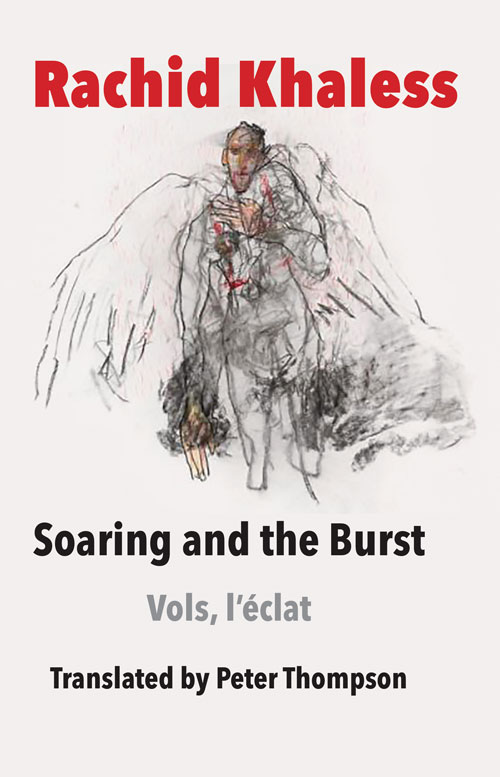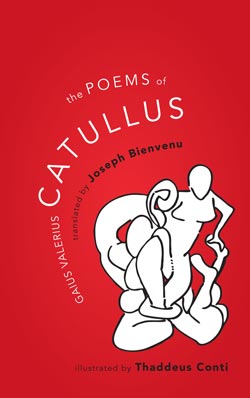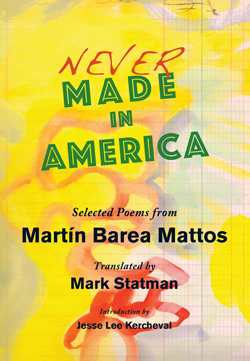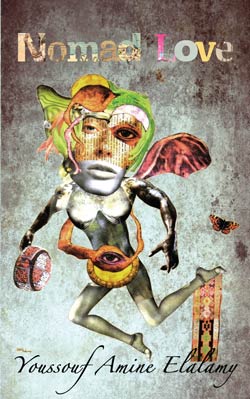Description
Rachid Khaless
Translated by Peter Thompson
Soaring and the Burst (Vols, l’éclat)
ISBN:978-1-956921-15-1 (pbk.)
(May, 2023) (Pre-order pricing through May 31.)
First full-length publication in English of the award-winning Moroccan poet, Soaring and the Burst (Vols, l’éclat) was awarded the Prix du Maroc du Livre, one of Morocco’s most prestigious prizes, in 2019.
Translator’s Preface
Rachid Khaless, as we’ve said in another space, bears watching. In his early fifties he is not just a literature professor at the prestigious Mohamed V, in Rabat, but he seems to be everywhere else: a poet, novelist, publisher, painter and translator. He is not necessarily typical of the new voice in Morocco, but his various resonances are the heart of that new voice: polymodal, transgressive, ironic and humane.
All this shows in his work as a publisher: Abdelhak Serhane’s Eros maudit ou le sexe des Arabes, Mohamed Loakira’s poetry of Arab Spring …and the spring is veiled over, and Mohamed Nedali’s achingly humane (while sharply critical of society) La Bouteille au cafard. As a novelist the psychological study within his Absolut Hob balances the broad societal view of a jihadi-bomber in Quand Adam a décidé de vivre. As a translator, Khaless takes on Hassan Najmi, one of Morocco’s most deceptively metaphorical and analogic poets and one who has both embodied traditional influences and developed a contemporary voice. As a poet, there is Khaless’s present work (published together with Dans le désir de durer in one volume, 2014): a book which indeed “soars” into abstraction and distance-from-self while constantly fueled by intensity of personal feeling. [Of all the titles cited only the Loakira has been translated into English (Diálogos Books, 2017); Khaless has not been translated; Najmi’s The Blueness of The Evening has been translated.]
This book, Vols, L’éclat, was first been published by the Maison de la Poésie au Maroc—itself an honor—and also won the Prix du Maroc du Livre (2019). And its soaring does, at first, take us out of a strictly literary comfort zone—that is, what we expect from poetry in terms of tone. Tone is a broad word, and the first distraction, the use of the first person “I,” certainly invites a broad discussion of tastes. In the English-speaking West, we tend to feel the discussion is settled, and we’re a bit averse to this pronoun in poetry. There was probably a wave of reaction, among us, to the “confessional poets,” then there was the influence of the Language poets, and no doubt other and occult vibrations in the zeitgeist have brought us to this standard. So we might, at first struggle with images such as:
A thousand metamorphoses
Tear me free from absence when
To cast up rainbows
In the skies I spill
My precious blood
In so many colors…
A sense of airy abstraction, the use of upper case letters, the personal pronoun (all present, by the way, in the work of contemporary Moroccan poets such as Abdelkhaleq Jayed, the Loakira of Confidences d’automne, and others) might lead us astray. The soaring might not be fully recognized as escape, transcendence and revelation—just as we might not be alert to its mirror: plummeting, plumbing, delving. We have to remind ourselves that there is something concrete about revelation, about the violence of “the burst.” For this translator, the tip comes with these lines:
Rifts in the wind
For my future resurrections
In stupendous towns
And for improbable
Republics—
A metaphysics. And perhaps we thought we were done (Donne) with that, as done as was Ayer (Alfred Jules) when he wrote the classic assault Language, Truth and Logic. Certainly, we feel that some of the abstraction inherent in metaphysics had been bled out of our (poetic) system with the advent and lasting influence of Surrealism and Imagism. Then why does the above remind us of Rimbaud? That is the key here: Rimbaud, the progenitor of an eerie blending of the abstract (metaphysical, at least with him) and the concrete—the progenitor of that synthesis which still influences our writing, especially our sense of metaphor—is echoed in this soaring.
This, from Rimbaud’s “Mystique” (Les Illuminations), is typical:
The flowery softness of the stars and sky and all the rest, it lowers opposite the hillside, like a basket facing our slope, and births the abyss, blossoming and blue, below. (PT, translation)
The “slope” is a geometric notation and the stars, after all, are pretty distant, but the sense of their bodies and of a real hillside rescues this from pure abstraction. At the same time the “abyss,” the “below” and perhaps the “flowery softness” (a noetic stumbling block for us, pertaining impossibly to stars) ring metaphysical. Why is this combination so powerful—and why, as this translator assumes, so attractive to Khaless?
It starts, oddly enough, with Rimbaud’s personal pronoun “I.” It is a very particular operation with this “je” (“I”) that invokes the metaphysics commented by Alice Coleno, Philippe Sollers, Esa Hartmann and others. This is the operation hinted at in the seventeen-year-old Rimbaud’s dictum “Car je est un autre” (“because I is another,” Letter to Paul Demeny, 1871). And if “I” is (third person) someone else, we (modern, Western readers) don’t take the first person pronoun in the same slightly irritating way we might have at first glance. Removing yourself from your being is also a distancing from all being—a removal to a new vantage point, a stance taken in confrontation with all that is familiar. That is the metaphysical glint that we constantly see in even the most abjectly, crudely concrete of Rimbaud’s images.
Khaless’s “soaring” is metaphysical in this sense. Even putting aside the great influence of Rimbaud on North African writers in French (see Dominique Poncelet, Hédi Abdel Jaouad and others), we have this same sense in Soaring and the Burst, and through this sense we recognize the “I” as “an other”—rather than an “I” with its everyday luggage of familiar self. While this poet seems to insist on revealing, he instead persists in marveling: at the new altitude, the new lines of sight, the new physical laws. The new phenomena are the fragments of the “burst,” objectively a new physics but more profoundly a new (“disordered” in Rimbaud’s sense) subjectivity.
The value of this work—beyond its startling imagery—is its extensive exploration of sense and sensibility without exploiting either the social world or a cloying introspection.
Stay with this writer in the soaring, follow the work of his Virgule Editions, plunder his own published list. His future has burst upon us.
—Peter Thompson
Roger Williams University







Reviews
There are no reviews yet.